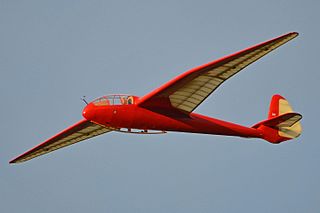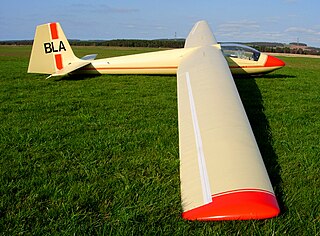
The Aer-Pegaso M-100 was a single-seat glider designed and built in Italy from 1957.
The Schneider ES-59 Arrow is a sailplane designed and manufactured in Adelaide, South Australia in the early 1960s. The Arrow was manufactured with a one-piece wing of 13.23 metres span. It was the first Australian-built sailplane to compete in the World Gliding Championships, 1963 in Argentina. The Arrow has wood/fabric wings and tail and a wood fuselage. It has a fixed main wheel and a nose skid.

The Schneider Grunau Baby was a single-seat sailplane first built in Germany in 1931, with some 6,000 examples constructed in some 20 countries. It was relatively easy to build from plans, it flew well, and the aircraft was strong enough to handle mild aerobatics and the occasional hard landing. When the Baby first appeared, it was accepted wisdom that the pilot should feel as much unimpeded airflow as possible, to better sense rising and falling currents of air and temperature changes etc.

The Slingsby T.21 is an open-cockpit, side-by-side two-seat glider, built by Slingsby Sailplanes Ltd and first flown in 1944. It was widely used by the Royal Air Force, Sri Lanka Air Force and by civilian gliding clubs.

The Slingsby T.41 Skylark 2 was a sailplane produced from 1953 by Slingsby Sailplanes at Kirkbymoorside, Yorkshire.

The Slingsby Type 42 Eagle was a two-seat glider designed in England from 1952.

The Slingsby T.37 Skylark 1 was a small low-cost sailplane built during 1952-3 at Kirbymoorside, Yorkshire by Slingsby Sailplanes.

The Slingsby T.6/T.23 Kirby Kite was a single-seat sport glider produced from 1935, by Fred Slingsby in Kirbymoorside, Yorkshire.

The Slingsby T.8 Kirby Tutor was a single-seat sport glider produced from 1937, by Fred Slingsby in Kirbymoorside, Yorkshire.
The Slingsby T.25 Gull 4 is a British glider designed and built by Slingsby that first flew in 1947.

The Eon Olympia was a glider produced from 1947 by Elliotts of Newbury.

The IS-5 Kaczka was a single-seat canard research glider designed and built in Poland from 1948.

The Slingsby Type 34 Sky is a high performance single seat competition sailplane built in the United Kingdom. It was successful in major events, particularly in the World Gliding Championships of 1952.

The Slingsby Type 45 Swallow was designed as a club sailplane of reasonable performance and price. One of the most successful of Slingsby's gliders in sales terms, over 100 had been built when production was ended by a 1968 factory fire.

The Slingsby T.13 Petrel was a British single-seat competition glider built by Slingsby Sailplanes just before World War II.

The Slingsby T.50 Skylark 4 was a British single seat competition glider built by Slingsby Sailplanes in the early 1960s. It sold in numbers and had success at national, though not world level competition.
The Kometa-Standard was a Standard Class glider, designed and built in Bulgaria in the early 1960s. Thirty were flown by local gliding clubs.
The UTG-1 Loudon was an intermediate glider designed and built at the University of Toronto in Canada during the late 1940s.
The IS-2 was an intermediate training glider designed by Iosif Şilimon and built in Romania in the 1950s at the URMV-3 factory at Brașov.
The IS-4 was a high performance glider designed by Iosif Şilimon and built in Romania in the late 1950s at the URMV-3 factory at Braşov.

















